| 1 | Master of nest raiding |
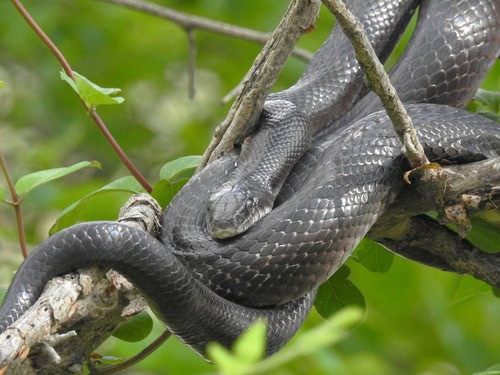
The eastern ratsnake (Pantherophis alleghaniensis) is an extremely widespread snake on the east coast of the USA, which can be found in virtually the entirety of Florida, through Georgia, the Carolinas, all the way to central Vermont. This is an extremely common snake which appears in many major cities, including Raleigh, Charlotte and Gainesville.
Naturally, black ratsnakes inhabit deciduous forests and thickets along field edges. But there’s something about the black ratsnake which makes them hyper-adaptable to manmade environments. Consequently, you can find them in back gardens, public parks, agricultural fields, even on streets in certain locations.
Black ratsnakes are a snake of many skills. They’re excellent tree climbers, and while they climb relatively slowly, they’re easily able to ascend vertical tree trunks, even manmade iron poles. They’re regularly found in dark attics, searching for food amid the cobwebbed rafters.
Black racers average at 100-180cm, with an all-time record of 228cm. They also have the claim to fame of being the eastern USA’s top bird-eating snake. Confirmed prey include American robins, northern cardinals, northern mockingbirds, house finches, blue jays and red junglefowl. Bats are confirmed, specifically the southern myotis bat. Eastern black ratsnakes prey on bird eggs as well, and it’s perfectly normal to find one resting by your garden fence with a round bulge moving slowly down its throat.
| 2 | Pretends to be aggressive |
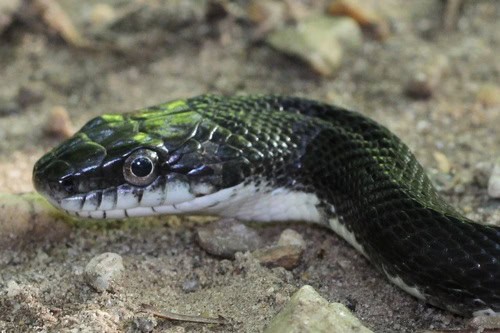
Eastern ratsnakes are a true constrictor, asphyxiating their prey with carefully applied coils. They lack any venom, and as well as birds, mammals dominate their diet. Occasionally, they prey on amphibians such as American bullfrog eggs.
When confronted, the eastern ratsnake copies the local rattlesnakes, yet lacks two things essential to their success: aggression and venom. Eastern ratsnakes will rapidly throw themselves into an S-shaped coil in mid-air, with their face facing the aggressor. They’ll make multiple mock lunges, like warnings, but if actually gripped, eastern ratsnakes tend to lose their aggression quickly. They’re safe to hold without suffering painful bites, unlike the black racer, another non-venomous Florida species, which is not just viciously nippy, but aims for the face.
Eastern ratsnakes are also a semi-communal snake. While hibernating, they can be found in forest rock crevices alongside timber rattlesnakes, copperheads, and eastern racers, resting side by side without attacking each other. That said, they’d probably attack a weekend forest explorer if they disturbed them.
| 3 | Two morphs: black and yellow |
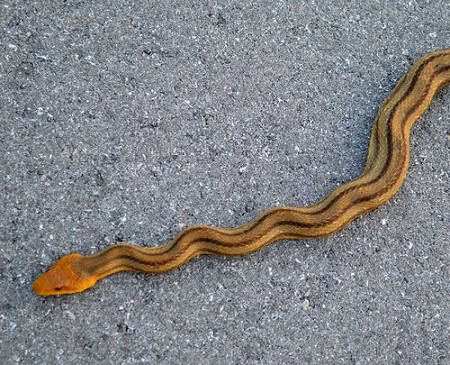
The eastern ratsnake is an egg-laying species, usually in batches of 5-27. Sawdust piles, compost heaps and decomposing logs are all favoured places to lay them. The eggs hatch from July to September, and at birth, eastern ratsnakes look very different to adulthood. They’re stony grey with darker blotches, more closely resembling a grey ratsnake (found further west).
Into adulthood, the grey vanishes and is replaced with either yellow or grey, which are morphs found within the same species. The yellow morph is most common in Florida, and is an orange-yellow overlaid with parallel lengthways stripes. Their tongue remains black. The more common morph, especially further north, is a pure black, hence the alternative name the black ratsnake. This is interspersed with occasional white specks, which is actually skin visible between its scales.
Eastern ratsnakes always have round pupils, with medium sized eyes. Like the corn snake, their body is adapted for tree climbing. In a cross section, their body is not round, but shaped like a loaf of bread, with a flattened belly, which has keeled scales to enable gripping in tree bark.
| 4 | Resting place: underwater logs |
The forest is full of possibilities and eastern ratsnakes have many places they can take shelter. Overgrown brush, cracks in tree trunks and hollow logs are all likely. But they have one favourite above all: hollowed out branches submerged in water. Eastern ratsnakes are especially common in thick branches which have detached from their parent tree, landed near water, then rotted away starting with the core. They can rest peacefully in these watery shelters for 1 day, 10 days, or up to 34 days. Some of these branches have had an opening just 5cm thick.
Eastern ratsnakes often rest inside these flooded branches with fellow species members, whereas they share space less commonly in dry refuges. This included males with females. and females with females. Scientists have noticed that pregnant females are the most likely to rest in submerged branches, hinting that they offer some advantage of childbirth, perhaps superior shelter against roaming predators, given the tiny 5cm openings.
When scientists created 56 artificial submerged cavities, and left them around woods in South Carolina, the ratsnakes ignored them. Only one ratsnake entered a fake shelter over 2 years, whereas when 45 eastern ratsnakes were tracked over 4 years, 22 of them rested in submerged logs. Eastern ratsnakes aren’t idiots, and have very specific natural characteristics they search for. Summer was the most likely time to find them in submerged logs.
| 5 | Nest-raiding tactics |
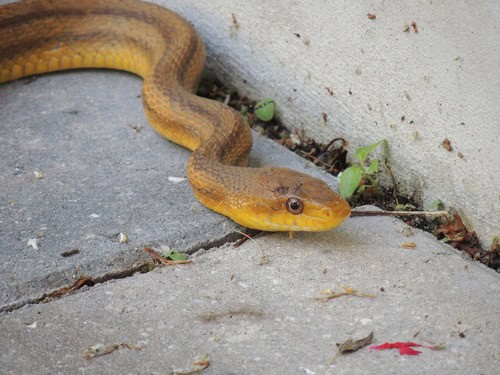
In 2015, a study compared the three main nest-raiding snakes of the eastern US: eastern racers, corn snakes, and the unrelated black racer (Coluber constrictor). The site was Savannah River country in South Carolina, right in the heart of eastern racer territory.
All 3 were skillful at slithering directly up tree trunks and raiding nests. Only black racers ate adult birds, but all three favoured nestlings above all, sometimes just 6 days old.
Black racers preyed on nests exclusively during daylight, while corn snakes were exclusively nocturnal. Eastern ratsnakes were the only species to raid nests during both day and night, though their peak hours were 20:00 and 22:00. Corn snakes raided their nests later in the night, including as late as 02:20.
Ratsnakes were also were less aggressive than their cousin. In 11 cases, corn snakes approached defensive adult birds closely enough to make contact. In 6 cases, they actually shoved the parent aside to access the nestlings beneath. Meanwhile, eastern ratsnakes only struck at adult birds 3 times, and never made actual contact with adults.
Overall, eastern racers were the highest ranked bird predator, accounting for 28% of nest failures, versus 15% for corn snakes, and 12% for black racers. Coachwhips contributed a small share at 5%. Eastern racers preyed on 6 eggs and 32 nestlings across the study.
| 6 | Prefers forest edges to centres |
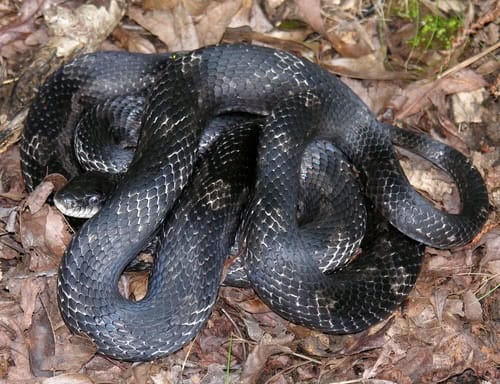
The eastern ratsnakes almost always (96%) ate their nestlings at the nest, as did corn snakes. Black racers often dragged nestlings away from the tree before swallowing (36% of the time). This is probably because black racers are much nimbler and faster, whereas ratsnakes are slower.
Failure was common, as eastern racers apparently fell from branches sometimes while creeping up on nests, landing on the ground below. In an April 2012 incident, scientists heard the distress call of a white-eyed vireo. They discovered an eastern ratsnake fleeing from a nest, with three adult vireos in hot pursuit and launching aggressive attacks. The nest contained 4-5 nestlings.
The nestlings were apparently saved, but later that day (20:05), a different eastern ratsnake arrived and ate them. The parents had apparently let their guard down and left on a hunting trip.
There were difference in habitats too. While black racers and eastern ratsnakes hunted nests primarily along forest edges, corn snakes raided nests deeper within forests. Additionally, black racers were more likely to hunt birds when close to a secure retreat structure, such as a log, tree stump or overgrown brush. This may be a cagier, more cautious snake, because black racers didn’t care about refuges at all. Occasionally, both corn snakes and eastern ratsnakes pinned nestlings with their bodies, which black racers never did.
| 7 | Uses bird feeders for ambush |
Eastern ratsnakes are the top bird-ambushing snake of the eastern seaboard, and they get inventive in pursuit of their morbid goals. The location was a garden in James City County, Virginia, containing an iron pole 1.25 metres high with two arms at the top: one with a bird feeder dangling and another holding a flower pot.
Scientists watched as a black ratsnake entered the garden, coiled around the pole like a piece of spaghetti, and wound its way slowly upwards over 16 minutes. All the while, hummingbirds were coming and going. The snake clambered onto the flowerpot, then turned its attention to the plastic bird feeder opposite, with its tongue flecking.
The hummingbirds noticed the hungry snake, as they stopped dead when 10cm in front of its face. Yet this didn’t faze them, and they continued to pick up sugar water from the feeder. Apparently, their decision was wise, as the ratsnake made several lunges but failed. The ratsnake then grew impatient, and slithered directly over the iron arms of the pole, bringing it closer to the bird feeder. Finally, it gave up after 57 minutes of failed hunting, and retreated to the grassy ground. While this ambush was a failure, hummingbirds are confirmed prey for eastern ratsnakes. This was a manmade bird feeder, so rather than waiting by flowers, eastern ratsnakes are intelligent enough to simply identify areas where they’re congregating.
| 8 | A relatively weak constrictor |
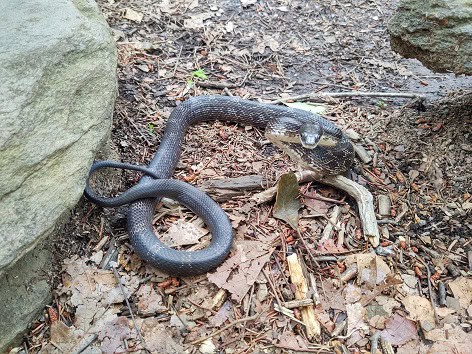
Meanwhile, a 2017 study compared ratsnake constriction powers to 3 kingsnakes’, with all 6 species originating in the USA. Eastern ratsnakes were one of 3 ratsnakes used, along with corn snakes, which they were significantly stronger than, and western ratsnakes, which they were slightly stronger than. However, all 3 were dwarfed for raw constriction strength by the kingsnakes.
When ratsnakes and kingsnakes applied equal numbers of coils to their prey in the laboratory, the kingsnakes also exerted greater constricting force. This was in spite of the ratsnakes’ larger length. The eastern ratsnake reaches a confirmed maximum of 228cm, while California kingsnakes peak at just 142.2cm. It’s all in their superior muscle fibres, and finely tuned instincts for arranging the utmost crushing coil. For example, kingsnakes were found to have a more uniform coil posture than ratsnakes.
It was found that the ratsnakes and kingsnakes had similar cross-sectional muscular area, and in both groups, this scaled similarly when the body sizes of individual snakes increased. It wasn’t raw muscle quantity that made kingsnakes superior. The test was fair, as both groups were given the same prey: the globally widespread house mouse (Mus musculus), which both kingsnakes and ratsnakes regularly prey on in the wild.
| 9 | Hawk wars |
Eastern ratsnakes not only constrict their prey, but use constriction defensively against predators. On 24 April 1998, a battle was observed with a red-tailed hawk (Buteo jamaicensis), which is probably the most snake-addicted bird in the entire USA, with a particular tendency to prey on gopher snakes. Scientists were exploring a forest access road in South Carolina, when they found a ratsnake and bird interwined in a struggle on the ground. The ratsnake had visible talon wounds, and its lower body was wrapped tightly around the hawk’s neck and chest.
The scientists knew that the ratsnake hadn’t initiated the battle, as it was blue-eyed and therefore shedding its skin, a time when snakes rarely hunt. The hawk was also far too large to be a meal.
As the ratsnake squeezed, the bird’s beak opened and its tongue protruded. The longer the struggle continued, the more the hawk lost strength, and it gradually sank to the ground. The ratsnake continued to squeeze and constrict even 10 minutes after the bird was clearly dead. Furthermore, the ratsnake noticed the human observers and struck at them several times.
Their western ratsnake cousin has also been seen fighting off a red-shouldered hawk, again coiling immediately around the neck, this time in Monroe County, Arkansas.
| 10 | The confusing family tree |
The Pantherophis ratsnake family is constantly chopping and changing. Overall, the clan has 8 members, including the corn snake, which inhabits the whole eastern US and is easily distinguishable from the others. The confusion lies with three closely related species, which were long switched between subspecies, one giant species, and completely independent.
As of 2024, the species are divided as so. Western ratsnakes (Pantherophis obselatus) lie exclusively west of the Mississippi river. Eastern ratsnakes (Pantherophis alleghensis) inhabit all of Florida, and the rest of the eastern seaboard up to Vermont, closely hugging the coast. Grey ratsnakes (P. spiloides) lie inbetween, beginning at the western panhandle in Florida, and covering all states on the eastern shores of the Mississippi.
According to a 2020 study, grey and eastern ratsnakes are estimated to have diverged 0.65 million years ago. It’s theorised that eastern ratsnakes became stranded in Florida by rising sea levels, diverged, then recolonized the north when global temperatures cooled. The Appalachian mountains may also have acted as a barrier; these hills spread from Georgia all the way through Maine. Meanwhile, the western ratsnake and the grey/eastern pair diverged 1.08MYA.
Because of the seperating Mississippi, the eastern two species are most easily confused. Grey ratsnakes and eastern ratsnakes sometimes intermingle in Georgia and northern Florida, but the former is obviously grey, while eastern ratsnakes are either dense black or striped yellow.
